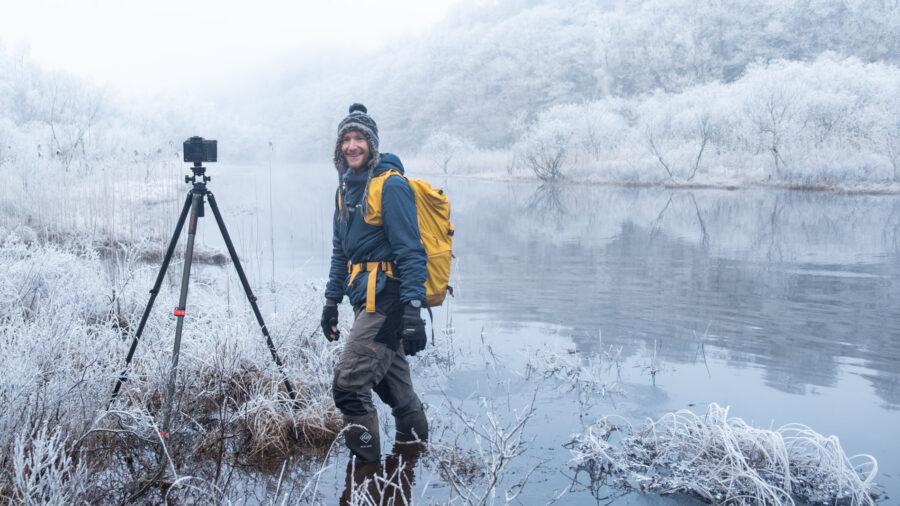In an era dominated by political and aesthetic extremes, Thomas Heaton consciously chooses the path of subtle in-betweenness. As a contemporary artist whose canvases resist clear classification as either abstract or figurative, he mirrors a culture’s longing for certainty, which is nonetheless shaped by contradictions. His art neither comfortably fits the familiar nor provokes with overt spectacle. Instead, his paintings unfold a delicate dialectic of ambiguity that challenges presumed certainties and grants the viewer an unusually high degree of interpretive freedom.
The Origin of an Artistic Vision
Born and raised far from major art metropolises, in the rural county of Cheshire, England, Thomas Heaton found his way to art via the Manchester School of Art. Away from the London spotlight, he developed an independent painterly perspective early on. Already during his studies, it became clear that he would push the boundaries of his medium be it by breaking with traditional themes or by questioning conventional exhibition practices. For his graduation project, he deliberately refrained from the usual wall display: his canvases instead hung freely in the space, forcing viewers to discover ever-new vantage points. This unconventional approach earned him early recognition in the local scene and remains characteristic of his work to this day. His awareness of the context and the conditions under which art is created and shown shapes Heaton’s practice. At the same time, he positions himself as a representative of a new generation of artists who forge their own paths in contemporary art, far from the major centers.

The Essence of the Moment: A Departure from Clarity
While much of contemporary art foregrounds personal identity, memory culture, or pointed social statements often as a reaction to the polarizations of our time, Heaton takes a more restrained approach. His works resist clear messages and easy categorization. This conscious restraint is not an expression of emptiness; rather, it opens up a space for thought: the viewer is invited to bring their own associations instead of receiving predetermined answers. In an art world that often expects loud manifestos, this refusal of unambiguous statements is not a sign of indifference but a commitment to complexity. Heaton’s neutrality challenges us to endure the world’s multifaceted nature instead of reducing it to simple categories.
His approach also aligns with a long tradition of questioning painterly clarity. The interplay of representation and abstraction has animated art for over a century; one thinks of Gerhard Richter’s famous blurs, which transform photographs into vibrating fields of color, or Francis Bacon’s distorted figures, which turn the familiar into the grotesque. Heaton works within this lineage of radical inquiry, though his approach appears more subtle and understated.
Whether in large-scale oil paintings or delicate works on paper, Heaton’s visual language evades quick consumption and denies any easy certainty. His paintings constantly oscillate at the threshold of the indeterminate, where the representational dissolves into the vague. He often uses a muted color palette, dominated by grays and blues, and a precise but disorienting brushstroke to create worlds that resist quick identification. A hinted figure or fragmented object may briefly flash, evoking a memory in the viewer, only to dissolve back into abstraction. One feels like a witness to a transformation: what just seemed familiar is suddenly strange and reassembled anew. This tension between familiarity and enigma gives Heaton’s work its quiet energy an aesthetic neutrality that neither soothes with the known nor agitates with the sensational, but lingers in the subtle in-between.

Between Recognition and Discourse: The Artist’s Reception
It is no coincidence that Heaton engages with art not only in the studio but also on a theoretical level, for example, in his current postgraduate studies in art history. This intellectual engagement with language and meaning is palpably present in his paintings. Every form seems like a sign that wants to be deciphered, yet as soon as one believes to have understood it, it recedes. Heaton explores the boundaries of what can be expressed through painting. In doing so, he also draws on the questions of conceptual art: since the 1960s, artists have been concerned with the relationship between image and word, but while many conceptual artists use text directly, Heaton lets painting itself speak. His works function like visual poems: open to interpretation, free from didactic clarity. The titles, too, offer no resolution: often just a single word, sometimes botanical, sometimes drawn from everyday life, they provoke questions rather than provide answers. In this way, he exposes the futility of simplistic assignments of meaning: his images are like the words of a foreign dialect tangible but never fully translatable.
Memory also plays a crucial role in Heaton’s art. His blurred motifs often resemble the afterimage of a dream or the shadow of a suppressed memory present, but without sharp outlines. A painting might, for instance, suggest the silhouette of a door, shrouded in a mist of gray, a supposed entry into a chamber of memory that never fully reveals itself. Such hints draw the viewer deeper into the image, only to leave them with open questions. Heaton challenges the viewer to fill these gaps with their own responses: every interpretation becomes subjective, shaped by personal experience and memory. In an era where digital media seem to archive every image and nothing is ever lost, Heaton’s painting insists that true memory is an active, creative act of the mind.

The Echo of Quiet Poetry: A Bridge to Contemporary Reality
Although Thomas Heaton is still at the beginning of his career, his work is already gaining broad recognition, particularly among curators and critics seeking new voices in British painting. Exhibitions in Manchester and beyond have shown that his quiet persistence resonates: viewers linger before his paintings, challenged by their resistance to a simple reading. The initial uncertainty before his elusive motifs often transforms into curiosity: with time, layer by layer, new details and possibilities unfold. Instead of providing quick answers, Heaton provokes a conversation; his work invites reflection on perception, ambiguity, and the nature of contemporary art.
Ultimately, a quiet poetry permeates Heaton’s work. In the detached atmosphere of his paintings, a gentle melancholy resonates the feeling of losing something familiar that was never entirely graspable. This emotional resonance is what makes his abstract compositions so captivating and unforgettable. Parallels can be found in other art forms: in literature, for instance, W.G. Sebald cultivated a similar interplay of memory and blur in his photo-illustrated narratives, a kindred spirit to Heaton’s painterly sensibility.
Amidst the deluge of digital images in our time, such a decelerated approach seems almost subversive. Heaton’s works consciously resist the fast consumption promoted by platforms like Instagram and demand time, silence, and a readiness for reflection. These qualities are gaining significance in current art discourse, and early critics have already highlighted how he subverts established dichotomies abstract versus figurative, personal versus political thereby providing a fresh impulse for contemporary debates.
Thus, Thomas Heaton’s art stands as an example of a new embrace of ambiguity. Instead of shying away from indeterminacy and blur, he elevates them to a principle and thereby opens up perspectives beyond conventional dichotomies. In an art world often driven by trends and loud spectacle, his work is a counter-proposal. He cultivates the quiet tones that resonate the longest. His art reminds us to recognize the beauty of the indeterminate. For it is precisely in this space of in-betweenness, this unsaid tension, that a transformative power arises, enriching our perception of contemporary reality.









